The Augmented Reality Market is estimated to be valued at USD 72.5 billion in 2025 and is projected to reach USD 1121.6 billion by 2035, registering a compound annual growth rate (CAGR) of 31.5% over the forecast period.
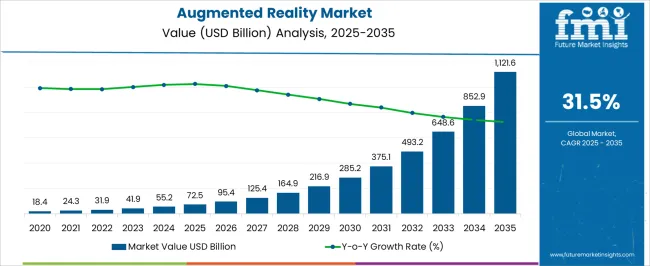
| Metric | Value |
|---|---|
| Augmented Reality Market Estimated Value in (2025 E) | USD 72.5 billion |
| Augmented Reality Market Forecast Value in (2035 F) | USD 1121.6 billion |
| Forecast CAGR (2025 to 2035) | 31.5% |
The augmented reality market is experiencing accelerated growth, supported by rising adoption across consumer, enterprise, and industrial applications. Increasing demand for immersive experiences in entertainment, coupled with expanding use cases in healthcare, retail, education, and manufacturing, is shaping the industry’s trajectory. Hardware advancements, particularly in optics, processors, and sensors, are enhancing performance while reducing device weight and improving user comfort, which is driving higher adoption rates.
At the same time, advancements in software platforms and developer tools are broadening application capabilities, enabling real-time interactivity and higher-quality visualization. Strong investments from technology companies and growing venture funding are supporting product innovation and ecosystem expansion. The integration of AR with 5G connectivity, cloud computing, and artificial intelligence is unlocking new business models and operational efficiencies, further stimulating market growth.
Regulatory support for advanced visualization in areas such as training and remote assistance is reinforcing adoption As consumer engagement and enterprise productivity tools converge, the augmented reality market is positioned to deliver strong long-term growth, driven by continuous innovation and expanding cross-industry applications.
The augmented reality market is segmented by component, display, application, and geographic regions. By component, augmented reality market is divided into Hardware and Software. In terms of display, augmented reality market is classified into HMD (Head-Mounted Display), Smart Glass, Head-up Display (HUD), and Handheld Devices. Based on application, augmented reality market is segmented into Gaming & Entertainment, Aerospace & Defense, Education, E-Commerce & Retail, Industrial & Manufacturing, and Others. Regionally, the augmented reality industry is classified into North America, Latin America, Western Europe, Eastern Europe, Balkan & Baltic Countries, Russia & Belarus, Central Asia, East Asia, South Asia & Pacific, and the Middle East & Africa.
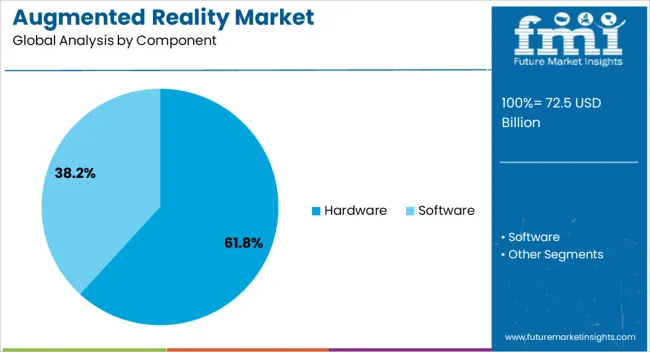
The hardware segment is expected to hold 61.8% of the augmented reality market revenue share in 2025, making it the largest component category. This leadership is being driven by the strong demand for AR-enabled devices such as head-mounted displays, smart glasses, and AR-compatible mobile hardware. Continuous improvements in display resolution, field of view, and processing power are enhancing user experience, making hardware adoption more widespread in both consumer and enterprise domains.
The need for specialized hardware to support immersive experiences in sectors such as gaming, healthcare, and industrial design is further reinforcing demand. Hardware manufacturers are increasingly integrating advanced sensors, cameras, and lightweight materials to improve usability and comfort, addressing a critical factor for sustained market penetration.
Strategic partnerships between hardware developers and software providers are also enabling more seamless ecosystems, ensuring that AR experiences can be delivered effectively across multiple use cases With large-scale investment in wearable technology and the miniaturization of components, the hardware segment is anticipated to maintain its dominance as the foundation of AR deployments globally.
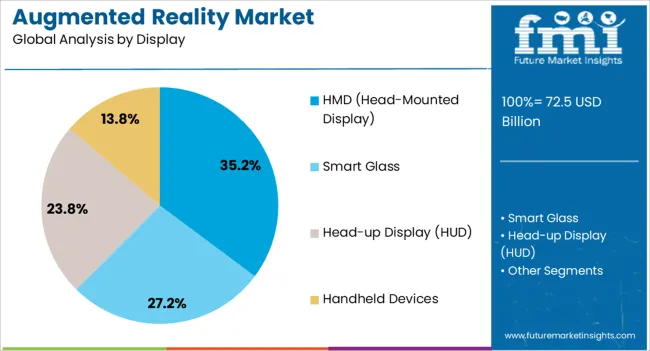
The head-mounted display application segment is projected to capture 35.2% of the augmented reality market revenue share in 2025, positioning it as the leading application category. Its dominance is being reinforced by its ability to deliver fully immersive experiences in both professional and consumer environments. Demand for AR-enabled HMDs is being fueled by growing adoption in fields such as remote collaboration, medical training, defense simulation, and education, where real-time visualization significantly improves outcomes.
In the consumer sector, lightweight and wireless HMDs are gaining traction in gaming and media consumption, enhancing interactivity and user engagement. Advancements in optics, ergonomic design, and display technology are improving comfort and usability, addressing one of the major barriers to broader adoption.
The growing investment in enterprise-grade HMDs by organizations aiming to enhance workforce training, operational efficiency, and safety is further supporting segment growth As hardware costs continue to decline and ecosystems expand, HMDs are expected to maintain a leading role in the augmented reality market, underpinning its largest adoption base across industries.
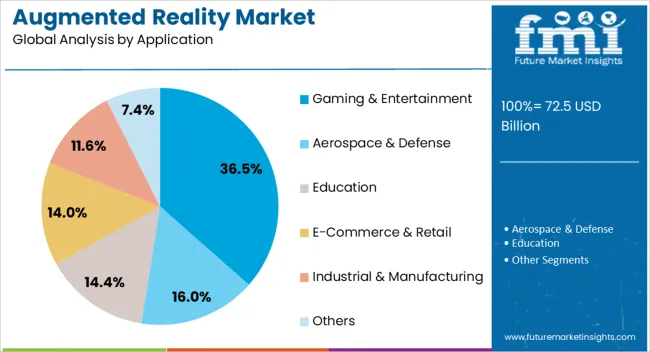
The gaming and entertainment segment is projected to account for 36.5% of the augmented reality market revenue share in 2025, making it the largest end-use area. This dominance is being driven by the rising demand for interactive and immersive experiences that merge physical and digital environments. AR in gaming is enhancing user engagement by enabling real-world integration, while in entertainment, it is transforming live events, theme parks, and streaming content.
Growing adoption of AR-enabled mobile devices and headsets is further accelerating expansion, supported by strong consumer interest and rising disposable incomes in key markets. Entertainment companies are investing heavily in AR to create differentiated content and attract broader audiences, reinforcing segment leadership. Integration with social media platforms is also driving engagement, as AR filters and interactive tools become central to user interaction.
The rapid pace of innovation in content creation, coupled with advancements in AR hardware and software, is positioning gaming and entertainment as the leading growth driver With strong support from both technology providers and media companies, this segment is expected to retain its dominance in shaping mainstream adoption of augmented reality solutions.
Augmented reality (AR) is on the brink of transforming the entire industrial workplace as well as consumers’ lifestyle. As per latest studies, the global augmented reality market is expected to grow at a tremendous over the forecast period, 2025-2035.
The ability of AR technology to combine real world with super-imposed images is attracting a humongous user base, with the number of mobile AR users slated to reach 2.4 billion by 2025, globally, as per Statista.
While tech giants have been extensively focusing on R&D activities in AR technology, SMEs and start-ups are also showing good signs. Case in point, NTT Docomo has invested US$ 280 Mn in Magic Leap, an AR start-up. Furthermore, players identifying the untapped potential of augmented reality will be better placed for outsized returns.
The automotive industry has been the early adopters of augmented reality technology and continue to be a major driver in its capital performance. Majority of automobiles incorporate AR-based heads-up displays (HUD) that predict information such as state of the vehicles’ systems, speed and mileage, and navigation directions.
Several high-end car models - Toyota Camry, Chevrolet Camaro, and BMW 7 Series – come with AR-based HUDs. Studies find that the adoption of AR-based HUDs is poised to reach about US$ 7 Bn by 2035.
The automotive industry is a conducive ground for innovation and automobile giants are heavily investing in AR automotive technologies that rethink the driving experience. ABI Research reveals that the overall market revenue of AR automotive technologies will surpass US$ 5 Bn in 2025, expanding at 177% CAGR.
While AR technology aids businesses in advancing their processes and services further, its implementation is cost-prohibitive, and requires methodical expertise. As such, application of AR is limited to large-scale enterprises.
AR technology helps in generating, analyzing, and gathering crucial data sets, thus, putting users’ privacy at risk. Moreover, AR systems that capture surroundings in real time raise legal concerns akin to that of shooting videos or pictures of casual individuals or their property, which is prohibited.
AR technology is highly addictive further leading to health problems such as lack of concentration, eye problems, and chronic pain.
North America and Europe continue to hold leading share in augmented reality market, backed by presence of established technology pioneers. As per Statista, by 2025, the number of AR users is expected to hit 85 million in the US alone. Further, the International Data Corporation (IDC) reveals that the US and Western Europe will witness the fastest growth in AR/VR by 2025 – 104.2% CAGR, and 96.1% CAGR respectively.
Going forward, Asia Pacific (APAC) is slated to show robust growth in augmented reality market over the following decade. Subsequent development of AR devices and software for commercial sector in countries such as China is propelling the market growth in this region.
Regional players are investing in R&D to launch various smartphone applications to ensure huge consumer penetration.
Market leaders are investing in R&D activities to scout out the unexplored areas of application to remain ahead of the curve. For instance,
OrcaMD has launched a medical app named EyeDecide to detect cataract or AMD and, thus, help patients understand the disease clearly.
Augmedics has launched an AR guidance system named xvision spine system to help patients visualize 3D anatomy of spine during surgery.
KaviAR Tech has developed an AR teleportation app that allows users to explore exotic destinations across the world.
Google has rolled out the beta version of its AR walking directions feature for Google Maps that will available to AR-compatible Android and iOS smartphones.
Such initiatives are boosting the product of portfolios of market players, helping them reap bigger returns and reach larger user base.
on the basis of the following,
By Technology
By Device Type
By Application
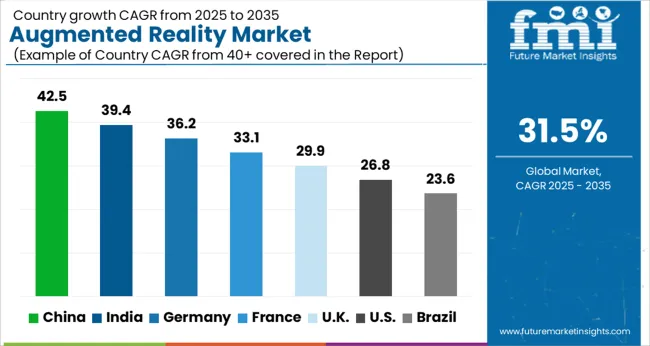
| Country | CAGR |
|---|---|
| China | 42.5% |
| India | 39.4% |
| Germany | 36.2% |
| France | 33.1% |
| Uk | 29.9% |
| USA | 26.8% |
| Brazil | 23.6% |
The Augmented Reality Market is expected to register a CAGR of 31.5% during the forecast period, exhibiting varied country level momentum. China leads with the highest CAGR of 42.5%, followed by India at 39.4%. Developed markets such as Germany, France, and the U.K. continue to expand steadily, while the U.S. is likely to grow at consistent rates. Brazil posts the lowest CAGR at 23.6%, yet still underscores a broadly positive trajectory for the global Augmented Reality Market. In 2024, Germany held a dominant revenue in the Western Europe market and is expected to grow with a CAGR of 36.2%. The U.S. Augmented Reality Market is estimated to be valued at USD 26.3 billion in 2025 and is anticipated to reach a valuation of USD 282.1 billion by 2035. Sales are projected to rise at a CAGR of 26.8% over the forecast period between 2025 and 2035. While Japan and South Korea markets are estimated to be valued at USD 3.8 billion and USD 2.4 billion respectively in 2025.
| Item | Value |
|---|---|
| Quantitative Units | USD 72.5 Billion |
| Component | Hardware and Software |
| Display | HMD (Head-Mounted Display), Smart Glass, Head-up Display (HUD), and Handheld Devices |
| Application | Gaming & Entertainment, Aerospace & Defense, Education, E-Commerce & Retail, Industrial & Manufacturing, and Others |
| Regions Covered | North America, Europe, Asia-Pacific, Latin America, Middle East & Africa |
| Country Covered | United States, Canada, Germany, France, United Kingdom, China, Japan, India, Brazil, South Africa |
| Key Companies Profiled | Microsoft, Google, Apple, Sony, Magic Leap, PTC, Blippar, Total Immersion, Wikitude, Daqri LLC, ODG, and Infinity Augmented Reality |
| Additional Attributes |
The global augmented reality market is estimated to be valued at USD 72.5 billion in 2025.
The market size for the augmented reality market is projected to reach USD 1,121.6 billion by 2035.
The augmented reality market is expected to grow at a 31.5% CAGR between 2025 and 2035.
The key product types in augmented reality market are hardware and software.
In terms of display, hmd (head-mounted display) segment to command 35.2% share in the augmented reality market in 2025.






Our Research Products

The "Full Research Suite" delivers actionable market intel, deep dives on markets or technologies, so clients act faster, cut risk, and unlock growth.

The Leaderboard benchmarks and ranks top vendors, classifying them as Established Leaders, Leading Challengers, or Disruptors & Challengers.

Locates where complements amplify value and substitutes erode it, forecasting net impact by horizon

We deliver granular, decision-grade intel: market sizing, 5-year forecasts, pricing, adoption, usage, revenue, and operational KPIs—plus competitor tracking, regulation, and value chains—across 60 countries broadly.

Spot the shifts before they hit your P&L. We track inflection points, adoption curves, pricing moves, and ecosystem plays to show where demand is heading, why it is changing, and what to do next across high-growth markets and disruptive tech

Real-time reads of user behavior. We track shifting priorities, perceptions of today’s and next-gen services, and provider experience, then pace how fast tech moves from trial to adoption, blending buyer, consumer, and channel inputs with social signals (#WhySwitch, #UX).

Partner with our analyst team to build a custom report designed around your business priorities. From analysing market trends to assessing competitors or crafting bespoke datasets, we tailor insights to your needs.
Supplier Intelligence
Discovery & Profiling
Capacity & Footprint
Performance & Risk
Compliance & Governance
Commercial Readiness
Who Supplies Whom
Scorecards & Shortlists
Playbooks & Docs
Category Intelligence
Definition & Scope
Demand & Use Cases
Cost Drivers
Market Structure
Supply Chain Map
Trade & Policy
Operating Norms
Deliverables
Buyer Intelligence
Account Basics
Spend & Scope
Procurement Model
Vendor Requirements
Terms & Policies
Entry Strategy
Pain Points & Triggers
Outputs
Pricing Analysis
Benchmarks
Trends
Should-Cost
Indexation
Landed Cost
Commercial Terms
Deliverables
Brand Analysis
Positioning & Value Prop
Share & Presence
Customer Evidence
Go-to-Market
Digital & Reputation
Compliance & Trust
KPIs & Gaps
Outputs
Full Research Suite comprises of:
Market outlook & trends analysis
Interviews & case studies
Strategic recommendations
Vendor profiles & capabilities analysis
5-year forecasts
8 regions and 60+ country-level data splits
Market segment data splits
12 months of continuous data updates
DELIVERED AS:
PDF EXCEL ONLINE
Augmented Reality (AR) Shopping Market Size and Share Forecast Outlook 2025 to 2035
Augmented Reality Glasses Market Size and Share Forecast Outlook 2025 to 2035
Augmented Reality for Retail Market
AR & VR Market Trends – Growth & Forecast 2017-2025
Augmented and Virtual Reality in Education Market - Growth & Forecast 2025 to 2035
Mobile Augmented Reality Market Analysis by Solution, Application, and Region Through 2035
Augmented Analytics Market Size and Share Forecast Outlook 2025 to 2035
Augmented Learning Market
Mixed Reality Navigation Platforms Market Forecast and Outlook 2025 to 2035
Mixed Reality Surgery Market Analysis - Size and Share Forecast Outlook 2025 to 2035
Extended Reality (XR) Market Trends – Growth & Forecast 2025 to 2035
Tourists Virtual Reality Headsets Market Insights - Growth & Forecast 2025 to 2035

Thank you!
You will receive an email from our Business Development Manager. Please be sure to check your SPAM/JUNK folder too.
Chat With
MaRIA